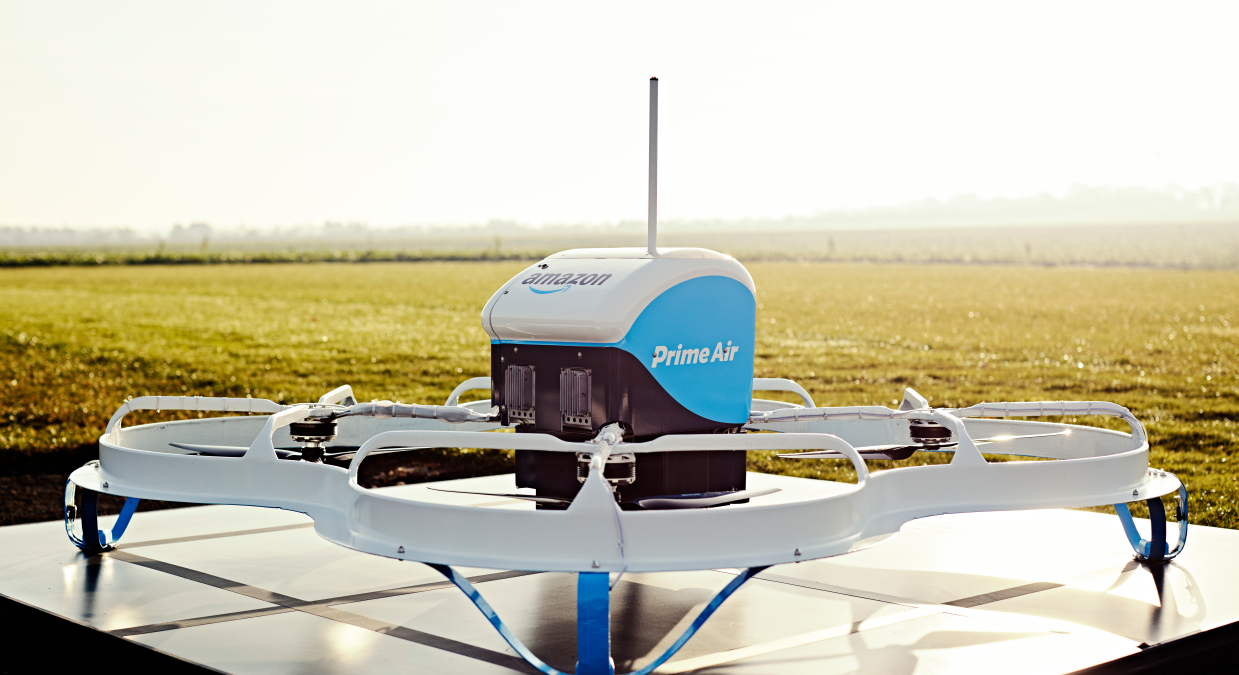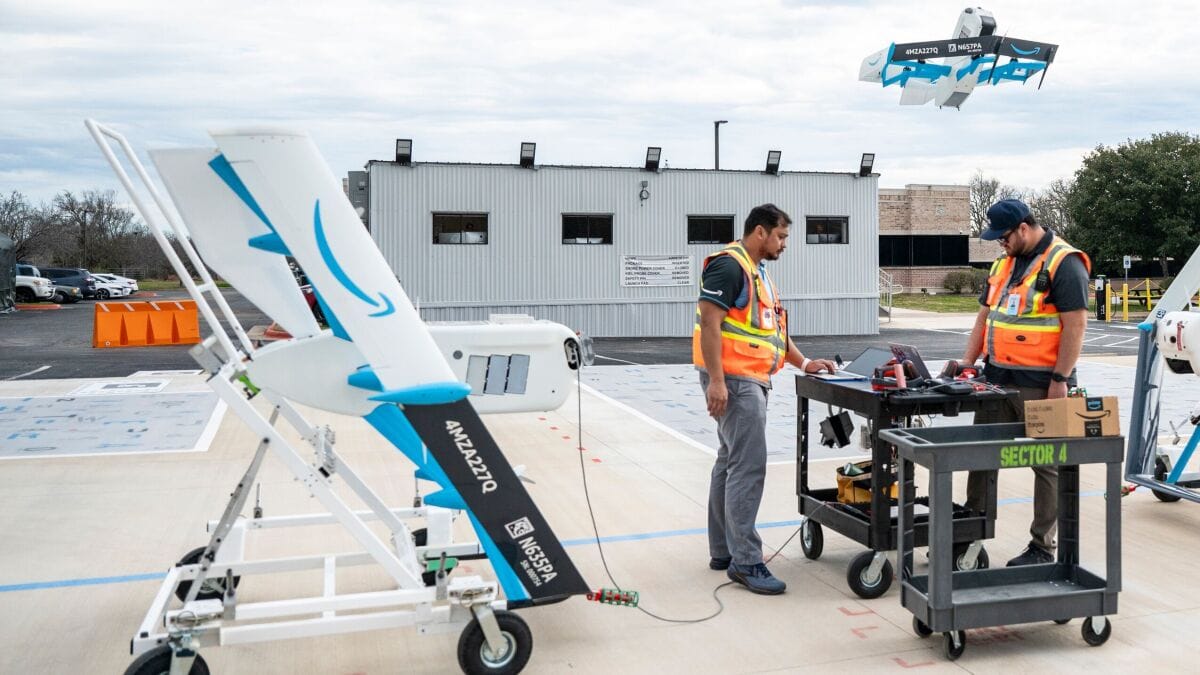 Amazon Prime is a drone delivery service operated by Amazon. The service uses delivery drones to autonomously fly individual packages to customers, and launched in 2022.The service currently operates in two cities in the US, with plans to expand into the UK and Italy in 2024.In 2020 the company, along with Zipline, Wingcopter and 7 others was selected by FAA to participate in a type certification program for delivery drones. Amazon has been given the green light to test-fly drones beyond a human controller’s line of sight in the UK, paving the way for using the machines to deliver packages to homes. Kirkwall airport in the Orkney islands will be one of the projects, testing how drones and other aircraft might operate safely alongside each other. Amazon said last year it wanted to launch home deliveries via drone in the UK and Italy before the end of 2024.It already offers drone deliveries in the US, in Locke ford, California, and College Station, Texas.
Amazon Prime is a drone delivery service operated by Amazon. The service uses delivery drones to autonomously fly individual packages to customers, and launched in 2022.The service currently operates in two cities in the US, with plans to expand into the UK and Italy in 2024.In 2020 the company, along with Zipline, Wingcopter and 7 others was selected by FAA to participate in a type certification program for delivery drones. Amazon has been given the green light to test-fly drones beyond a human controller’s line of sight in the UK, paving the way for using the machines to deliver packages to homes. Kirkwall airport in the Orkney islands will be one of the projects, testing how drones and other aircraft might operate safely alongside each other. Amazon said last year it wanted to launch home deliveries via drone in the UK and Italy before the end of 2024.It already offers drone deliveries in the US, in Locke ford, California, and College Station, Texas.
 Amazon said 28th it has received federal approval to fly its delivery drones longer distances without the need for ground spotters, clearing a key regulatory hurdle and opening the door for the company to scale the service to more parts of the U.S Previously, Amazon was required to fly its drones within a pilot’s view. The Federal Aviation Administration’s approval allows Amazon to conduct flights beyond an observer’s line of sight. In 2022, Amazon said it would begin testing deliveries in College Station, Texas, about 100 miles northwest of Houston, and Locke ford, a town south of Sacramento where the program was initially met with some skepticism by residents. It is also eyeing further expansion to other U.S. cities in 2025. The company has said it aims to deliver 500 million packages by drone per year by the end of the decade.
Amazon said 28th it has received federal approval to fly its delivery drones longer distances without the need for ground spotters, clearing a key regulatory hurdle and opening the door for the company to scale the service to more parts of the U.S Previously, Amazon was required to fly its drones within a pilot’s view. The Federal Aviation Administration’s approval allows Amazon to conduct flights beyond an observer’s line of sight. In 2022, Amazon said it would begin testing deliveries in College Station, Texas, about 100 miles northwest of Houston, and Locke ford, a town south of Sacramento where the program was initially met with some skepticism by residents. It is also eyeing further expansion to other U.S. cities in 2025. The company has said it aims to deliver 500 million packages by drone per year by the end of the decade.
—Model of Amazon Prime Drone—
In addition to the new delivery sites, Amazon is unveiling the new MK30 drone design, which is quieter, smaller and lighter, than previous models. The MK30 is quieter and will be able to fly in more diverse weather conditions — meaning customers can access quick deliveries even in situations like light rain, and hotter and colder temperatures. The drones have a unique package delivery system, where packages are held inside the machines during transit to protect their contents. The system can detect objects that were not there the day before, such as a freshly planted tree, or a mobile crane that has moved into its path. The current Amazon Prime’s drone can fly up to 15 miles, and it can carry a maximum weight of 5 pounds.
—Steps Behind A Drone Delivery—
- Here are some interesting facts about how a package is delivered by drone:
- Boxes used for drone delivery have customized cushioning technology called a “trampoline,” which is placed at the bottom of the box to protect items during delivery.
- A fresh battery is placed inside the drone for each delivery.
- Each drone undergoes a detailed inspection to ensure that it is safe to fly. This includes a top-to-bottom inspection from the propellers down to the frame. If the drone does not pass inspection, it will be replaced.
- Once the drone is cleared to fly, an employee will first load the battery followed by the package inside the drone, which will then be launched 400 feet into the air.
- When the delivery is completed, the drone flies back to the facility—under employee monitoring—to find its allocated landing pad and land safely.


-Benefits from Amazon Prime Drone-
- Fastest Delivery
- Reduce reliance on vehicles
- Reduce traffics in cities
- Reduced environmental pollution
- Easier access to remote and rural areas
—Fastest Delivery—
Unlike vehicles that have to go through traffic and follow a specific road, drones have no particular route. They get to be quicker, and they can follow the shortest routes, delivering the packages in less time. This could revolutionize same-day delivery, as well as delivery of perishable items, and “could be especially useful for urgent or time-sensitive deliveries, such as prescription medications or emergency supplies.”
—Reduce reliance on vehicles—
When ordering from nearby, drones can cut delivery times substantially. Unlike vehicles that have to go through traffic and follow a specific road, drones have no particular route. They get to be quicker, and they can follow the shortest routes, delivering the packages in less time. The remotely operated flying machines can get to any location using GPS coordinates — and can get there quickly. Despite this, their use cannot yet be implemented widely and can also pose logistical and privacy issues.
—Reduce traffics in cities —
Drones will reduce the number of trucks used to deliver the packages. This will reduce traffic congestion, which is an issue in major cities around the World.
—Reduced environmental pollution—
Delivery trucks mostly use diesel, which contributes to carbon dioxide and other greenhouse gas emissions when burnt. Since fewer trucks will be in use, there will be less pollution.
—Easy access to remote areas—
Drones can have easier access to remote and rural areas that may not have the infrastructure required for planes and trucks. Drones can land in any spot and don’t require open spaces or pavement. This could be especially effective in disaster zones or medical emergencies.
–Disadvantages in Amazon’s Drone–
- Privacy risk
- Limited Carrying Weights
- Safety
—Privacy risk—
Drones have a history of surveillance use, and many of the features used for that purpose would also be necessary for deliveries. The source expounded, “Drones typically use a camera and GPS to navigate delivery destinations, which many believe to be intrusive.” In general, the public may not be comfortable with drones flying over their neighborhoods. Invasive bonus: Overhead cameras can potentially see into homes or yards, especially in more spread-out areas.
—Limited Carrying Weights—
Most drones are only approved to carry packages that are less than 3 kg. Only a few companies have been authorized to carry packages weighing at least 55 pounds. It poses a challenge when a customer orders a more massive package path. The current Amazon Prime’s drone can fly up to 15 miles, and it can carry a maximum weight of 5 pounds.
—Safety—
Drones have a history of surveillance use, and many of the features used for that purpose would also be necessary for deliveries. The source expounded, “Drones typically use a camera and GPS to navigate delivery destinations, which many believe to be intrusive. Drones use cameras and GPS to fly to the destinations. Some people are uncomfortable with these devices flying over and spying on their homes
Artical written by V.Harishram



